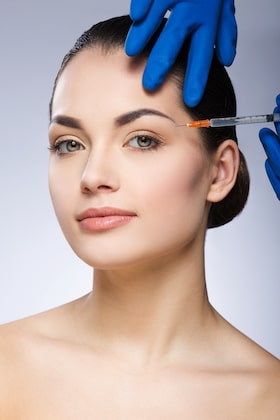
As a person ages, signs of aging can start to appear on the face and this includes visible signs such as wrinkles on the forehead, frown lines, and crow’s feet. These conditions can be addressed by the placement of Botox in the face in the targeted area. The botulinum toxin that is part of Botox injections is able to prevent the muscles in the treated area from contracting and causing the formation of lines and wrinkles. Since the muscles are not able to contract, the face is able to maintain a look that is smoother and youthful. However, there are times when the Botox that is injected travels to areas on the face that were not part of the treatment plan. For example, Botox that travels to the eyelids can result in a droopy look to the eyelid.
 If the Botox that was injected in an area of the face such as the forehead migrates towards the area between the eyes or the forehead, this can result in ptosis AKA a droopy eyelid.
If the Botox that was injected in an area of the face such as the forehead migrates towards the area between the eyes or the forehead, this can result in ptosis AKA a droopy eyelid.
If a patient wants to address the vertical frown lines that form “11 lines” above the nose, they can have Botox injected just above the brow or between the eyebrows. There is a chance for some of the Botox to make its way into the upper eyelid which can paralyze the muscle that holds up the upper eyelid (the levator muscle). Once this muscle is paralyzed, the upper eyelid will start to gain a droopy look.
When Botox is injected into the forehead of a person to lessen the look of forehead wrinkles, this task is accomplished by preventing the frontalis muscle that raises the eyebrow from being able to contract. This type of Botox injection usually provides the forehead with a smooth appearance, but it can also cause the eyebrow to descend. In turn, this can crowd the upper eyelids to the point that they have a look that is drooping.
The first step to treating a droopy eyelid after a Botox injection might not be the answer desired by the patient. Botox is not a permanent treatment, so the first step is to simply wait for the issue to resolve on its own. The length of the results from a Botox treatment depends on the individual patient and the amount of Botox injected into the treated area. Even though the results can typically last anywhere from four to six months, the issue of a droopy eyelid can resolve on its own around four to six weeks after the treatment.
In addition to waiting for the Botox results to resolve on their own, the use of eyedrops, such as apraclonidine, can help the patient with the appearance of a drooping eyelid (but not drooping eyebrows).
The patient can also have an additional amount of Botox injected by a medical professional in order to counteract the impact on relaxed eyebrow muscles. The injection must be made in the right place in the targeted area which means the person who injects the additional Botox needs to be professionally trained and experienced in treating this type of issue.
Once Botox is injected into the desired area on the face, it can take about a week for the injected toxin to bind itself to nerve receptors. Once the binding step occurs, the nerves in the treated area will not be able to trigger the muscles to contract. In other words, the muscle will be paralyzed for a period of three or four months and wrinkles will not be able to form during this time.
The medical professional needs to make sure that the Botox injections only impact the muscles in the area of the injection. This requires the doctor to make an educated decision about the proper place to inject the Botox as well as the ideal depth to avoid any migration of the Botox to other areas on the body. If the medical professional makes some sort of miscalculation, such as placing the injection in too low of an area in the forehead muscle, the result can be a droopy eyelid.
It is also important for the doctor to examine the current condition of the skin of the patient to make sure the person is an ideal candidate for a Botox treatment. The patient also needs to ask questions about the training and experience of the doctor so they can feel confident that their choice of a medical professional is experienced and able to provide the desired results.
If droopy eyelids are an issue after the treatment, the patient should immediately contact the doctor to schedule another appointment. The doctor can explain the treatment options listed above so the person with the droopy eyelid can make an informed decision about how to address the issue with their eyelids.
- MA